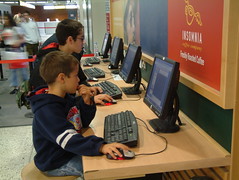In the first of six articles included in the International Review's "
The Impact of Instructional Technology Culture on Developing Countries," authors Moghaddam and Lebedeva share their preference for the term
low-income societies instead of
developing countries, since "all societies are developing in some form, " even the United States. The term low-income societies still acknowledges income differences in the world. The authors share that four billion of seven billion people live on less than two dollars a day.
The main educational challenge still faced by most of the world is to provide their young the rudimentary resources, such as a pencil and a paper pad, for elementary verbal and mathematical literacy.
As someone working with technology, I feel I sometimes lose sight of the fact that many people cannot even fathom my concerns over trying to get faculty to use a tablet PC or the e-clickers. They are saving their money to buy a piece of paper and then ironing the ink out of that paper to get more use from it.
Unfortunately, technology begins by serving the elite of any society regardless of income status. This is where the article gets interesting. Rather than focusing on the differences between high and low income societies, the authors focus on the differences between the elite and non-elite in all societies. The authors argue that there is a fundamental difference between how the elite and non-elite look at the world. Even in the poorest countries, there is a small number of people with Internet access and access to technology. These elite are more likely to be influenced by western thought by traveling, attending university in the west, and by exposure the western thoughts via the Internet. The non-elite are more likely to be uneducated, illiterate, and live in rural areas without access to technology.
This makes me think about how technology is impacting other countries and it seems like it is impacting different people in different ways. Unfortunately, the article does not give any solutions for how to empower the non-elites to gain access to technology and use it for their purposes and not just to spread western thought.
This brings me to another thought I had while reading these articles. Perhaps my view that everyone should have access to technology to learn and work is short-sighted. Authors Leh and Kennedy, in their article "Instructional and Information Technology in Papua New Guinea," made me realize that it is not just about access to the Internet. It is also about literacy and relevance. Let's face it, bringing Internet access to a small rural village won't help anyone if they don't know how to read and interpret the information. And even if they could, is it relevant to their lives? Instead of trying to spread what we think is useful technology, we need to ask others, "what do you need help doing?" Then, technology can be used to help with the problems that are relevant to them. So, maybe the solution is not Internet access, but instead, a piece of hardware that helps fishermen do their jobs more efficiently. This is something I'd like to keep in mind while helping faculty use technology in their classes. Instead of presenting technology as something they should use, I need to encourage them to see a problem they have that could be solved by using technology.
But, I still wonder. What is the most appropriate way to share technological advance with non-elites? Is it appropriate to assume that what is useful for me is useful for others? Should we pressure non-elites to gain exposure to technology because we know the good it can do? Or should we accept when others are not interested. I have not fully formed my thoughts on this topic.






